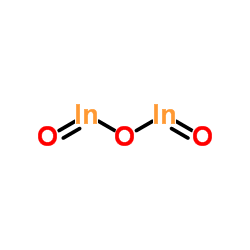

氧化铟结构式

|
常用名 | 氧化铟 | 英文名 | Indium Oxide |
|---|---|---|---|---|
| CAS号 | 1312-43-2 | 分子量 | 277.634 | |
| 密度 | 7.18 | 沸点 | 850ºC | |
| 分子式 | In2O3 | 熔点 | 2000ºC | |
| MSDS | 中文版 美版 | 闪点 | N/A |
|
Sensing behavior of YSZ-based amperometric NO₂ sensors consisting of Mn-based reference-electrode and In₂O₃ sensing-electrode.
Talanta 88 , 318-23, (2012) Yttria-stabilized zirconia (YSZ)-based amperometric NO(2) sensors comprised of an In(2)O(3) sensing-electrode (SE), a Pt counter-electrode (CE) and a Mn(2)O(3) reference-electrode (RE) in both tubular and rod geometries were fabricated and their sensing chara... |
|
|
Efficient photocatalytic hydrogen production by platinum-loaded carbon-doped cadmium indate nanoparticles.
ACS Appl. Mater. Interfaces 4(5) , 2426-31, (2012) Undoped and carbon doped cadmium indate (CdIn(2)O(4)) powders were synthesized using a sol-gel pyrolysis method and evaluated for hydrogen generation activity under UV-visible irradiation without the use of a sacrificial reagent. Each catalyst powder was load... |
|
|
Negative gate bias and light illumination-induced hump in amorphous InGaZnO thin film transistor.
J. Nanosci. Nanotechnol. 13(11) , 7535-9, (2013) While observing the transfer characteristics of a-IGZO TFTs, it was noticed that a hump occurred in the subthreshold regime after light and bias stress. This study analyzes the mechanism of the hump occurrence. It was determined that hump characteristics were... |
|
|
Enhanced gas sensing properties of multiple networked In2O3-core/ZnO-shell nanorod sensors.
J. Nanosci. Nanotechnol. 13(5) , 3427-32, (2013) The influence of the encapsulation of In2O3 nanorods with ZnO on the H2S gas sensing properties was studied. In2O3-core/ZnO-shell nanorods were fabricated by a two step process comprising the thermal evaporation of an 1:1 mixture of In2O3 and graphite powders... |
|
|
Electrical and optical properties of indium zinc oxide (IZO) thin films by continuous composition spread.
J. Nanosci. Nanotechnol. 13(5) , 3317-20, (2013) Indium zinc oxide (IZO) films were deposited on glass substrate at room temperature using off-axis RF sputtering-continuous composition spread (CCS) system. The full range composition of IZO films were controlled by the deposition rate and thickness profiles ... |
|
|
Spectroscopic studies of In2O3 nanostructures; photovoltaic demonstration of In2O3/p-Si heterojunction.
J. Nanosci. Nanotechnol. 13(1) , 498-503, (2013) The thermal oxidation process of the indium nitride (InN) nanorods (NRs) was studied. The SEM studies reveal that the cracked and burst mechanism for the formation of indium oxide (In2O3) nanostructures by oxidizing the InN NRs at higher temperatures. XRD res... |
|
|
Diffraction properties of the nanostructured surface.
J. Nanosci. Nanotechnol. 12(11) , 8856-9, (2012) The photosensitive In2O3-p-InSe heterostructures in which the In2O3 frontal layer has a nanostructured surface were investigated. The photoresponse spectra of such heterostructures are found to be essentially dependent on surface topology of the oxide. The ob... |
|
|
Thickness dependence of the strain, band gap and transport properties of epitaxial In2O3 thin films grown on Y-stabilised ZrO2(111).
J. Phys. Condens. Matter 23(33) , 334211, (2011) Epitaxial films of In(2)O(3) have been grown on Y-stabilised ZrO(2)(111) substrates by molecular beam epitaxy over a range of thicknesses between 35 and 420 nm. The thinnest films are strained, but display a 'cross-hatch' morphology associated with a network ... |
|
|
Orientation dependent ionization potential of In2O3: a natural source for inhomogeneous barrier formation at electrode interfaces in organic electronics.
J. Phys. Condens. Matter 23(33) , 334203, (2011) The ionization potentials of In(2)O(3) films grown epitaxially by magnetron sputtering on Y-stabilized ZrO(2) substrates with (100) and (111) surface orientation are determined using photoelectron spectroscopy. Epitaxial growth is verified using x-ray diffrac... |
|
|
Harnessing thermal expansion mismatch to form hollow nanoparticles.
Small 9(1) , 56-60, (2013) Nano popcorn: a new formation mechanism for the synthesis of hollow metal oxide nanoparticles through a melt fracture mechanism. The hollow nanoparticles are formed via brittle fracture following the generation of tensile stresses arising due to liquid-phase ... |